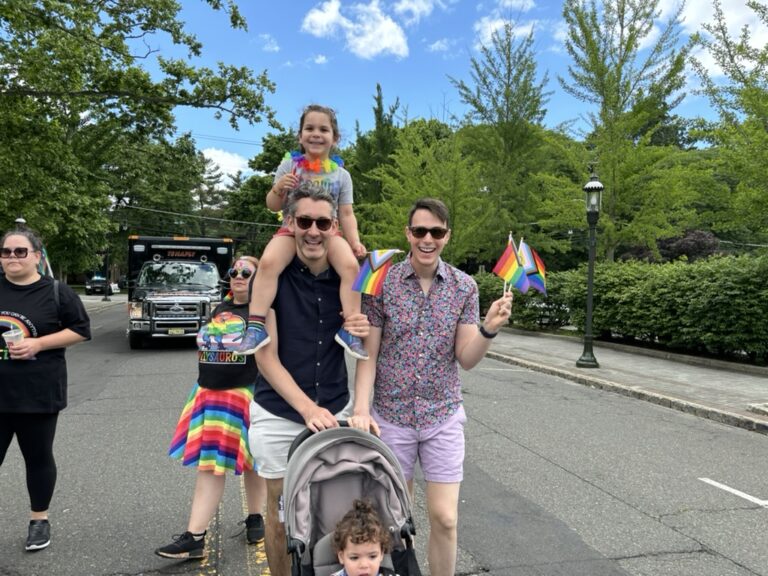When I started Luminary People Advisors, my very first blog post was about Pride. One year later, after working with so many incredible organizations, it feels right to return to this topic—especially as the national conversation around Pride and the LGBTQ+ community has shifted dramatically.
On a personal level, this moment takes me back to my wedding day, almost eight years ago. In my vows, I wrote:
“Today is surreal for many reasons. Of course, marrying someone who is absolutely extraordinary is remarkable itself, but for the majority of my life, I figured that even if I found such a person, any commitment that followed would be symbolic at most. I never thought this happiness was in the cards for me.”
Those words still resonate—especially in a year when the LGBTQ+ community faces renewed hostility and the painful reality of seeing support pulled back by institutions that once claimed to stand with us.
One of the cruelest aspects of this moment is the message it sends to young people: that they should feel hopeless about their futures, and that the challenges they face today are theirs to carry alone. My own childhood was full of joyful moments, but also marked by that same sense of doubt: Would a fulfilling life, let alone one with love and family, ever be possible for me? I didn’t know then that marriage could be in the cards for me—and I especially didn’t know if and how children would be. Yet today, I have two lively, inquisitive, and wonderful daughters, ages two and five.
Recently, I told my five-year-old that her two dads weren’t always allowed to get married, and that it was a relatively new right. She looked completely aghast, sad, and confused. A reminder that kids breathe in the world adults create for them—our fears, our ignorance, and our courage too.
We’ve seen again and again how quickly people forget the lessons of history. Pride itself grew out of protest. At Stonewall in 1969, trans women of color like Marsha P. Johnson and Sylvia Rivera stood at the front lines, demanding dignity and respect. Yet here we are, decades later, watching a new wave of hostility aimed at the trans community, echoing the stigma that gay people faced not so long ago.
In 2023 alone, more than 500 anti-LGBTQ+ bills were introduced across the United States, with a record number targeting trans youth. Alarmingly, that pace has only accelerated since the current administration took office. LGBTQ+ youth who experience discrimination are twice as likely to report suicidal thoughts. These are not just statistics; they’re daily reminders that progress can easily be undone—and that our work is far from over.
So, as Pride Month arrives, and corporate sponsors shy away from the rainbow logos they eagerly posted last year, what can we do? As I’ve written before, support for underrepresented communities cannot just be fair-weather or driven by social capital—it has to be a sincerely held commitment.
Here are a few concrete ways organizations can step up:
🌈 Speak up—especially when it’s inconvenient. Make it clear, both internally and externally, where you stand. Tie it back to your mission and values, and don’t apologize for standing for what’s right. This is especially critical in healthcare organizations, but it applies everywhere. Speaking up isn’t just about drafting a corporate statement during Pride Month—it’s about challenging harmful remarks, asking tough questions when partners waver, and ensuring LGBTQ+ perspectives are represented in every decision, even when the conversation is tense or the budget is tight. That’s what makes support real.
🌈 Review your policies through an inclusive lens. Examine parental leave, for example: do your policies assume a birthing parent is always present? Do they treat non-gestational parents as less involved? My own journey as a gay dad through egg donation and surrogacy—and my husband’s experience running a surrogacy agency—has taught me how crucial it is to build policies that fully support all families, especially those who have navigated uncertainty, stress, or financial barriers to become parents.
🌈 Support LGBTQ+-owned small businesses. When planning events or working with vendors, intentionally choose businesses that reflect your values. Intentionalist has a great list here: LGBTQ-owned businesses.
🌈 Balance joy and learning. Pride programming should celebrate resilience, history, and community. Drag bingo is fun—and I’ve seen it bring people together—but pair it with education about the LGBTQ+ community’s history, including the pivotal role of trans people of color in Stonewall and the ongoing fight for equality. Consider hiring speakers from the community for paid engagements to bring lived experiences and authentic perspectives to your teams.
🌈 Elevate leadership voices. Statements of support shouldn’t just come from a single person or an ad hoc committee. Every member of the leadership team should be prepared to speak up and demonstrate that inclusion is a core value, not a box to check.
🌈 Go beyond the workplace. This isn’t a topic that ends at the office door. It shows up in conversations at home, at the dinner table, and in classrooms. Especially now, when disinformation and bigotry are gaining ground, challenge ignorance and prejudice wherever you see it. Don’t seek conflict, but don’t cower from discomfort either.
As I’ve often said, we don’t just need allies—we need co-conspirators. If you have the privilege and the platform, use it. Speak up. Open doors. Create space. Because even though the fight for LGBTQ+ rights is far from over, every small act of courage and compassion adds up.
I’d love to hear how you and your organizations are supporting Pride this year. Let’s keep pushing for a world where no child—and no adult—has to wonder whether they can find love, build a family, or live authentically.
May this Pride Month remind us of the power of community and the impact of every voice. Happy Pride! 🏳️🌈 🏳️⚧️


